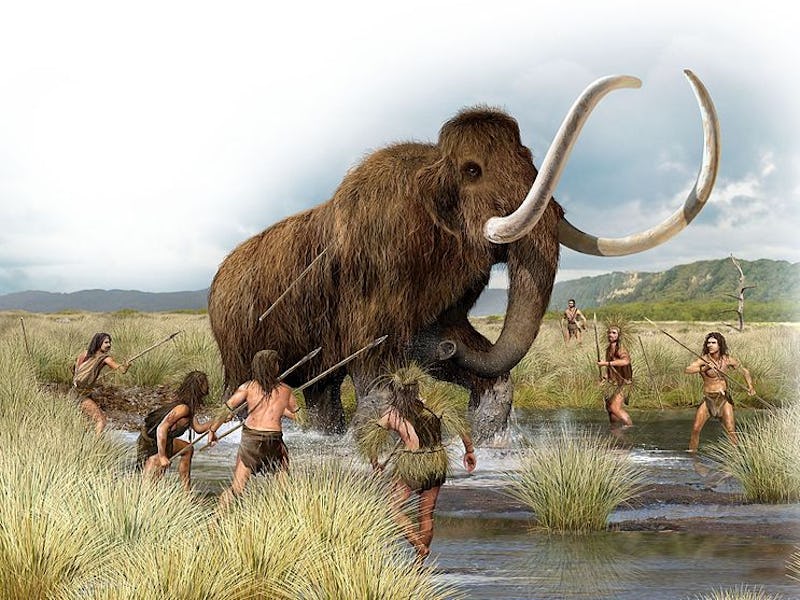How Neanderthals and Woolly Mammoths Grew "Genetically Similar" in the Cold
"They say ‘you are what you eat.'"

The woolly mammoths came first — huge, shaggy proboscideans that evolved from an African ancestor and arrived in Europe around 3 million years ago. Next came the Neanderthals, a now-extinct species of human who settled in proximity to the mammoths at least 400,000 years ago. These two mammals lived side by side during the Ice Age, a frigid period that brought them close together. So close, in fact, that they became genetically similar, according to new research in Human Biology.
While you don’t typically think of sharing essential genetic adaptions with your food, that’s exactly what linked Neanderthals to their prey. In the study published April 4, scientists from Tel Aviv University explain that the two extinct mammals shared epigenetic adaptations that may have allowed them to thrive in cold environments in similar ways.
Epigenetic adaptations are molecular changes to the genome — often a response to the environment — that affect how certain genes are expressed. These changes are not written in the DNA code, but they can be passed down through generations.
“They say ‘you are what you eat,’” lead author Ran Barkai, Ph.D., said. “This was especially true of Neanderthals; they ate mammoths but were apparently also genetically similar to mammoths.”
From an exhibition on Neanderthals in Paris.
Barkai and his team came to this realization while analyzing previous studies on Neanderthal and woolly mammoth genetics. Each of those studies found that the genomes of both mammals carried gene variants (parts of a genome that differ between two different genomes) and alleles (different versions of a gene variant, which arise by mutation) that are associated with cold-climate adaption.
Three essential pieces of evidence emerged: First, both mammoths and Neanderthals had the LEPR gene, which is related to the process of heat production in organisms and the regulation of fat storage in the body. Secondly, both mammals had variants of the genes MC1R and SLC7A11, which are linked to hair and skin pigmentation. Since there was variation at those genes, an advantageous mutation must have occurred when Neanderthal and mammoth ancestors came to Eurasia — likely as a response to the cold.
Finally, both woolly mammoths and Neanderthals carried an allele that controls keratin production. This allele affected the production of layers of skin and hair — think of the woolly part of the woolly mammoth. Scientists believe that this genetic detail helped Neanderthals adapt and stay warm in the cold environments of Eurasia. They also hypothesize that when some Neanderthals mated with Homo sapiens and passed this allele on to their hybrid children, the trait helped modern humans survive in the colder environment as well.
Woolly mammoths and Neanderthals, the team concludes, responded to environmental pressures with epigenetic adaption. Certain genes switched on and off, while others became modified as the two mammals evolved far away from their ancient origins in Africa. The adaptation allowed them to survive for a time, but not endlessly: Both species are now famously extinct. Wooly mammoths died out around 4,000 years ago, outliving the Neanderthals, who started going extinct 40,000 years ago.
“It is now possible to try to answer a question no one has asked before: Are there genetic similarities between evolutionary adaption paths in Neanderthals and mammoths?” asks Barkai. “The answer seems to be yes. This idea alone opens endless avenues for new research in evolution, archeology, and other disciplines.”
Abstract:
With the ongoing growth of gene-based research in recent decades, the possibility of examining changes that have taken place in structures over the course of evolution has become increasingly accessible. One intriguing subject at the forefront of evolutionary research is that of how environmental pressures affect species evolution through epigenetic adaptation. In this paper we present the available molecular components of adaptation to cold environments in two extinct mammals – the woolly mammoth and the Neanderthal. These two species co-existed in similar geographic and environmental European settings during the Middle and Upper Pleistocene and both were direct descendants of African ancestors, although both fully evolved and adapted in Europe during the Middle Pleistocene. In order to assess the degree of resemblance between mammoth and Neanderthal genetic components, we reviewed three case studies of relevant gene variants and alleles associated with cold-climate adaptation found in both genomes. Our observations present the likelihood of a molecular resemblance between the suites of cold adaptation traits in the two species, and we discuss their possible meaning for future research.